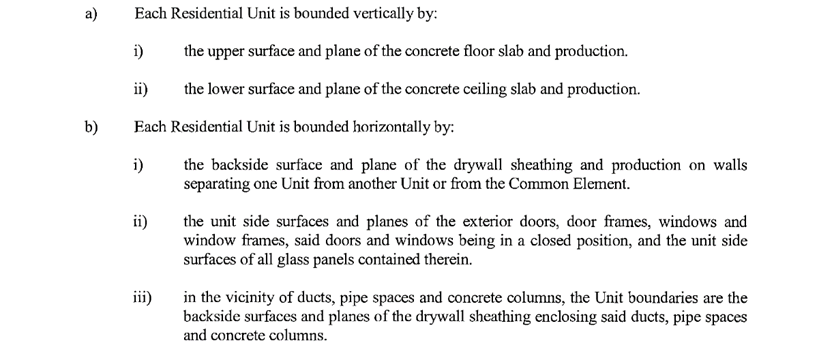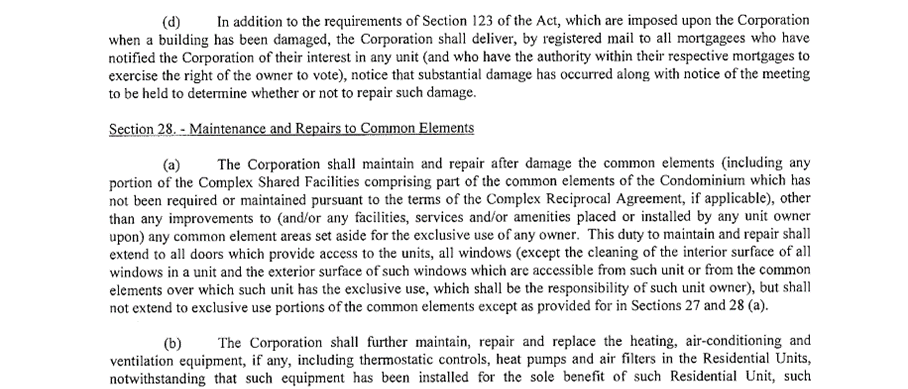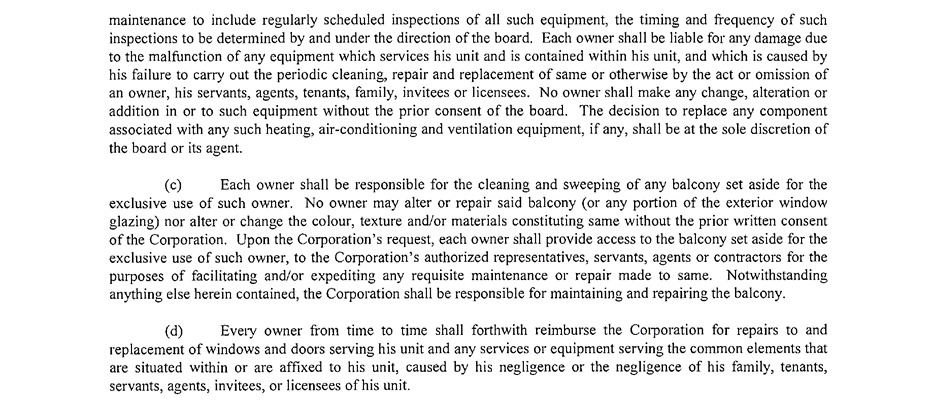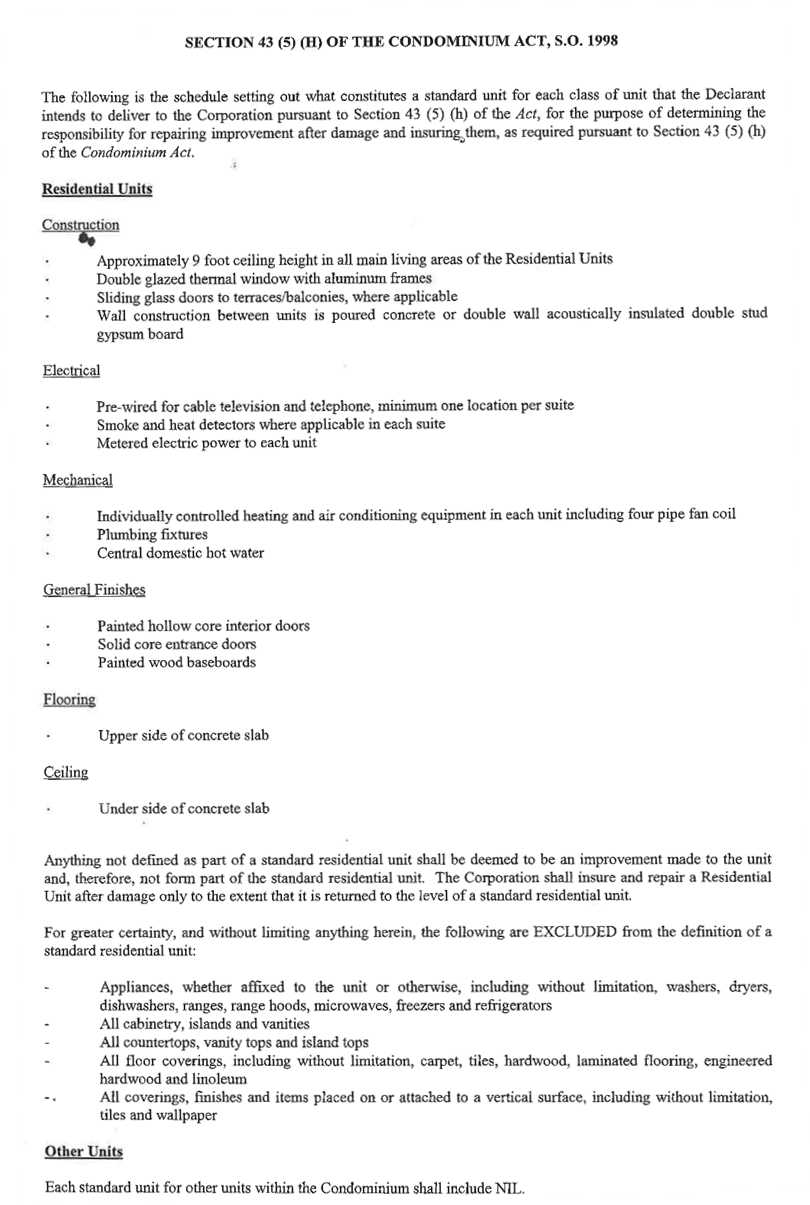Damages
The purpose of this section is to refer unit owners and occupants to relevant areas of the governing documents of TSCC 2510 as they pertain to repairs to residential units, particularly with respect to the distinction between common elements, common elements over which an owner has exclusive use, and residential units.
This discussion is significant because The Corporation is generally responsible to maintain (and repair after damage) the common elements, other than any common elements over which an owner has exclusive use [Declaration, S. 27(a), 28(a)]. Unit owners must maintain, at their own expense, their own units, and common elements over which they have exclusive use, with some limited exceptions. Unit owners are also responsible for damages they cause to the common elements and/or other units [Declaration, S. 27(b)].
Important: this notice is intended to direct readers to relevant sections of The Corporation’s governing documents. This document is not a bylaw or a governance document. The Corporation’s declaration and bylaws take precedent over any information presented in this notice. This document may not be relied upon for any legal proceeding or claim and does not represent any promise or obligation of the Corporation. The Corporation reserves the right to change its position on the interpretation of its declaration and bylaws from time to time and may changes its policies without notice. The Corporation’s declaration has precedence over the bylaws and rules of The Corporation.
This section covers:
the definition of a unit, and the types of repairs for which unit owners are responsible,
repairs that are typically the responsibility of the condominium corporation, and
the Corporation’s role in repairing damages caused by unit owners when the unit owner does not repair the damage in a timely manner.
This notice is based on information in The Corporation’s declaration.
Responsibilities
Scope of repairs
In all cases the Corporation or units that cause damage are only responsible to repair affected units to the minimum requirements of the standard unit definition. This means, for example, that damage to your unit's drywall, irrespective of the cause of the damage, is your responsibility to repair. The Corporation strongly urges all owners to obtain sufficient insurance. Throughout this document, references to "repairs" should only be interpreted as the minimum repairs required to restore a unit to the standard unit definition.
Damage originating within an owner’s unit
When a problem in your unit damages your unit
An owner is responsible to repair their unit and common elements over which they have exclusive use [Declaration S. 27(a)]. This includes elements like plumbing and ventilation that service the unit exclusively as outlined in Section 3 below [Declaration S. 5(a)]. The owner must complete these repairs within a reasonable time of being notified by the corporation.
Example 1: If a smoke alarm in a unit requires replacement because it is emitting an end-of-life warning beep, the corporation will notify the unit owner. If the work is not performed within a reasonable time, The Corporation will perform the work and charge back all costs to the unit owner (elaborated below).
Example 2: If a backdraft damper connecting the unit’s exhaust systems to the exterior of the building requires replacement due wear and tear, the unit owner is responsible for these costs. In some cases, it is not immediately apparent whether a damaged damper is exclusive to a given unit, and may require investigation by the property manager or The Corporation’s contractors.
If investigation reveals the defective damper is exclusive to the unit, then the unit owner is responsible for the repair costs as well as any investigative work.
If investigation reveals the defective damper is not exclusive to the unit (i.e. services several units), The Corporation is responsible for repairing the damper and for the investigation costs. The Corporation may not be responsible to repair any damage to the features inside the unit necessary in order to make the repair (e.g. drywall removed); this responsibility depends on case-specific factors.
When a problem in your unit damages another unit or the common elements
If a problem originates in an owner’s unit (or exclusive-use common elements) (“Unit A”) and affects other unit(s) or the common elements (“Unit B”):
The owner of any other affected unit (Unit B) will report the damage to The Corporation (the property manager), or the property manager will identify the damage from a report or inspection.
The corporation will notify the owner of Unit A (in writing) of the damage they must repair. The owner of Unit A must repair the damage within a reasonable time [Declaration S. 27 (c)].
If the owner of Unit A does not perform the work in a reasonable time, The Corporation will perform the repair at the expense of the owner of Unit A (see “Timeframe for repairs” below).
The repairs must restore Unit B and/or the common elements to the standard unit condition and be performed by an appropriately-qualified contractor.
The owner of Unit A may delegate this work to The Corporation, which has established relationships with qualified contractors who can perform the work at reasonable rates.
There is an exception for damages covered by The Corporation’s insurance.
Damage originating from outside an owner’s unit
If damage to a unit occurs from outside of the boundaries of that unit, the unit owner should report the damage to management. Management will perform an evaluation of the source of the damage.
If the source of the damage is from another unit (or common elements over which that unit owner has exclusive use), the owner of the unit where the damage originated is responsible for repairing the damage (as outlined above).
If the source of the damage is from common elements that over which the unit owner has exclusive use, then the unit owner is responsible for the repairs, even if those common elements are outside the standard boundaries of the unit or are connected to shared common elements. For example, this may include (but is not limited to): plumbing servicing the unit, ducts, vents, wiring, fire safety equipment, etc. The unit owner must perform the repairs within a reasonable time, or The Corporation will perform the repairs at the unit owner’s expense (see above). Limited exceptions apply, as summarized in the “Specific Areas” section below.
If the source of the damage is from common elements shared by more than one unit, The Corporation is responsible for repairing the damages
Example 3: If a unit negligently overflows their bathtub, and it leaks down affecting the two floors below it, the at-fault unit owner is responsible to repair the damage to the two units below it. If the owner doesn't perform the repairs, or cannot perform the repairs, the Corporation will facilitate the repairs and charge back costs to the at-fault unit owner. Under the declaration, the at-fault unit is only responsible for repairs required to restore to the standard unit definition. Costs for items outside the standard unit definition, such as drywall, flooring, and personal belongings, cannot be recovered through the corporation.
Performing repairs to damages caused by another unit
If the unit owner of a damaged unit (“Unit B”) hires their own contractors to repair damages caused by another unit (“Unit A”), the Corporation will not assist the owner in recovering costs, and the Corporation will not be responsible for any part of these repairs. Owners are discouraged from this option, because unit owners do not benefit from the same cost recovery options available to The Corporation (i.e. placing a lien on a unit).
Entitlement to repairs and reimbursement beyond standard unit definition
The Corporation takes no position as to whether owners may be entitled to claims against other unit owners for damages beyond the costs required to restore the unit to the standard unit definition. The Corporation isn't able to share information about specific units. The declaration has a subrogation clause S. 33 (a) which may prevent a unit's insurer from seeking damages from the owner or insurer of another unit.
Timeframe for repairs
Any party (whether the Corporation or a Unit Owner) responsible for a repair must do so in a reasonable amount of time. A reasonable time is not defined in the declaration but in practice depends on the nature and severity of the damages, whether the damage poses a safety risk, and how quickly the repairs can reasonably be performed. If a unit owner responsible for a repair does not perform a repair within a reasonable time, the corporation will make the repairs using contractors it chooses. If this happens, the owner of the unit causing the damage is deemed to have consented to the repairs, and must repay the corporation for the cost of the repairs as well as any legal or collection costs incurred in order to collect the costs of the repairs, with an interest rate of 24% per year [Declaration S. 27 (c)].
Unit Boundaries and Standard Unit
Boundaries
Units include: | Units exclude: |
Vertical bounds:
Horizontal bounds:
[Declaration Schedule C] The following elements which provide services to that particular unit:
[Declaration S. 5(a)] | The following elements which supply service or support to other units or the common elements (even if these elements are within the boundaries of the unit):
Exterior doors and door frames Windows and window frames [Declaration S. 5(a)] |
Specific areas of boundaries
Heat pumps: heat pumps are considered part of a unit, but The Corporation must maintain and repair all heat pumps [Declaration S. 27(a)].
Heating, Ventilation, Air Conditioning, Filters, and Controls (“HVAC”): The Corporation maintains and repairs HVAC equipment and may replace the equipment at its discretion. However, if an owner (or their tenants or visitors) damages HVAC equipment in their unit (e.g.: neglecting to clean or repair it, physical damage, etc.), the owner is responsible for the repair. Unit owners cannot make changes to HVAC equipment without the consent of The Corporation’s Board of Directors. The decision to replace any HVAC component is at the discretion of the Board of Directors and management. [Declaration S. 28(b)]
Windows: The Corporation is not responsible for cleaning the inside of windows, or for windows that can be accessed from balconies [Declaration S. 28(a)].
Balconies: Unit owners must clean and sweep their balconies, and may not modify the balcony or windows without The Corporation’s consent. The Corporation is responsible for repairs and Maintenance to balconies. [Declaration S. 28(c)].
Damage caused by negligence: If a unit owner (or their tenant, guests, etc.) damages the common elements (including, but not limited to, their balcony or HVAC equipment), the unit owner is responsible for the related repairs. [Declaration S. 28(d)].
Smoke Alarms: Units contain both individual smoke alarms (which detect smoke/carbon monoxide inside the unit and sound an alarm within the unit), and smoke detectors and alarm systems connected to the building at large (which detect smoke in the common areas and sound an alarm across the building). Unit owners are responsible for repairing and maintaining the smoke alarms that service their units specifically, whereas The Corporation is responsible for the fire safety systems connected to the condominium’s systems. [Declaration S. 5(a)].
Flooring, wall tiles, drywall, cabinetry, trim, interior doors, and other finishes inside a unit: elements like these fall within the boundaries of a unit and are the unit owner’s responsibility to repair (unless damaged by the common elements, or by another unit as described above).
Indemnification: The declaration indemnifies The Corporation from loss, damages, injuries, costs, or liabilities originating with acts or omissions of owners and occupants of units with respect to the common elements or other units [Declaration S. 29]. There is an exception for damages covered by the Corporation’s insurance.
Standard unit
The definition of a standard unit is critical because the Corporation is only responsible to repair damages to restore the unit to the standard unit definition. Our standard unit definition is as follows:
Construction
Approximately 9 foot ceiling height in all main living areas of the Residential Units
Double glazed thermal window with aluminum frames
Sliding glass doors to terraces’balconies, where applicable
Wall construction between units is poured concrete or double wall acoustically insulated double stud gypsum board
Electrical
Pre-wired for cable television and telephone, minimum one location per suite
Smoke and heat detectors where applicable in each suite
Metered electric power to each unit
Mechanical
Individually controlled heating and air conditioning equipment in each unit including four pipe fan coil
Plumbing fixtures
Central domestic bot water
General Finishes
Painted hollow core interior doors
Solid core entrance doors
Painted wood baseboards
Flooring
Upper side of concrete slab
Ceiling
Under side of concrete slab
Anything not defined as part of a standard residential unit shall be deemed to be an improvement made to the unit and, therefore, not form part of the standard residential unit. The Corporation shall insure and repair a Residential Unit after damage only to the extent that it is returned to the level of a standard residential unit.
For greater certainty, and without limiting anything herein, the following are EXCLUDED from the definition of a standard residential unit:
Appliances, whether affixed to the unit or otherwise, including without limitation, washers, dryers,
dishwashers, ranges, range hoods, microwaves, freezers and refrigerators
All cabinetry, islands and vanities
All countertops, vanity tops and island tops
All floor coverings, including without limitation, carpet, tiles, hardwood, laminated flooring, engineered hardwood and linoleum
All coverings, finishes and items placed on or attached to a vertical surface, including without limitation, tiles and wallpaper






